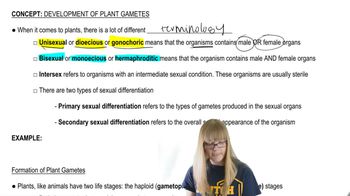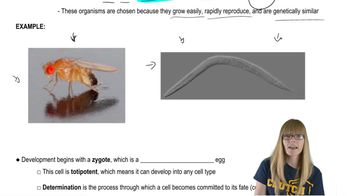Table of contents
- 1. Introduction to Genetics51m
- 2. Mendel's Laws of Inheritance3h 37m
- 3. Extensions to Mendelian Inheritance2h 41m
- 4. Genetic Mapping and Linkage2h 28m
- 5. Genetics of Bacteria and Viruses1h 21m
- 6. Chromosomal Variation1h 48m
- 7. DNA and Chromosome Structure56m
- 8. DNA Replication1h 10m
- 9. Mitosis and Meiosis1h 34m
- 10. Transcription1h 0m
- 11. Translation58m
- 12. Gene Regulation in Prokaryotes1h 19m
- 13. Gene Regulation in Eukaryotes44m
- 14. Genetic Control of Development44m
- 15. Genomes and Genomics1h 50m
- 16. Transposable Elements47m
- 17. Mutation, Repair, and Recombination1h 6m
- 18. Molecular Genetic Tools19m
- 19. Cancer Genetics29m
- 20. Quantitative Genetics1h 26m
- 21. Population Genetics50m
- 22. Evolutionary Genetics29m
14. Genetic Control of Development
Studying the Genetics of Development
Problem 3
Textbook Question
Carefully distinguish between the terms differentiation and determination. Which phenomenon occurs initially during development?
 Verified step by step guidance
Verified step by step guidance1
Understand the definitions: Differentiation refers to the process by which a cell becomes specialized to perform a specific function, while determination is the process by which a cell's fate is set, meaning it is committed to becoming a particular cell type.
Identify the sequence: Determination occurs before differentiation. During development, a cell first becomes determined, meaning it is committed to a specific fate, and then it undergoes differentiation to acquire the specialized characteristics of that fate.
Consider examples: For instance, a stem cell in the embryo may first become determined to become a muscle cell, and later, it will differentiate to develop the specific structures and functions of a muscle cell.
Explore the mechanisms: Determination is often influenced by genetic and environmental factors, such as gene expression patterns and signaling molecules, which guide the cell towards a specific fate.
Summarize the relationship: In summary, determination sets the path for a cell's development, while differentiation is the process of following that path to become a specialized cell type.
Recommended similar problem, with video answer:
 Verified Solution
Verified SolutionThis video solution was recommended by our tutors as helpful for the problem above
Video duration:
2mPlay a video:
Was this helpful?
Key Concepts
Here are the essential concepts you must grasp in order to answer the question correctly.
Differentiation
Differentiation is the process by which unspecialized cells develop into specialized cells with distinct functions. This process involves changes in gene expression that lead to the formation of various cell types, such as muscle, nerve, or blood cells. Differentiation occurs after cells have been determined, meaning they have committed to a specific fate.
Recommended video:
Guided course

Plant Gamete Terminology
Determination
Determination refers to the process by which a cell becomes committed to a specific developmental pathway, leading to a particular cell type. This commitment occurs before differentiation and is influenced by intrinsic factors (like genetic programming) and extrinsic signals (such as growth factors). Once a cell is determined, it will follow a specific trajectory in its development.
Recommended video:
Guided course

Sex Determination
Developmental Sequence
In the context of embryonic development, the sequence of determination followed by differentiation is crucial. Determination occurs first, establishing the cell's fate, while differentiation follows, resulting in the functional specialization of the cell. Understanding this sequence is essential for grasping how complex organisms develop from a single fertilized egg.
Recommended video:
Guided course

Sequencing Difficulties

 8:30m
8:30mWatch next
Master Genetics of Development with a bite sized video explanation from Kylia Goodner
Start learningRelated Videos
Related Practice


